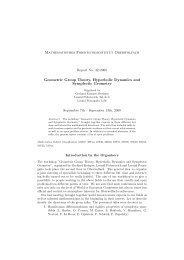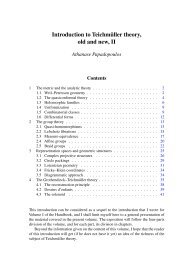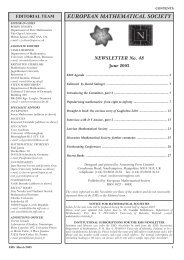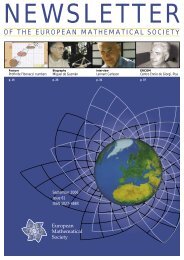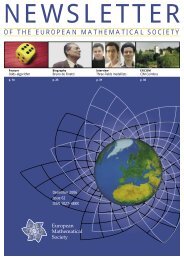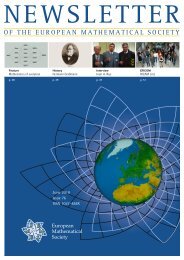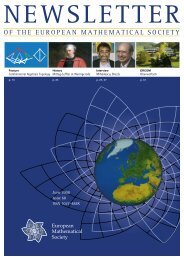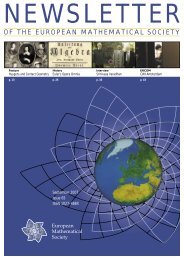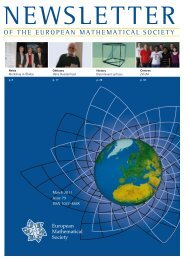New from Springer - European Mathematical Society Publishing ...
New from Springer - European Mathematical Society Publishing ...
New from Springer - European Mathematical Society Publishing ...
You also want an ePaper? Increase the reach of your titles
YUMPU automatically turns print PDFs into web optimized ePapers that Google loves.
Feature<br />
BBC radio, Melvyn Bragg’s programmes In our Time<br />
regularly deal with mathematical topics: recent examples<br />
have included Archimedes, probability, maths and music,<br />
symmetry, <strong>New</strong>ton’s Principia, Poincaré, and Gödel’s<br />
incompleteness theorem: such programmes take mathematical<br />
ideas to some two million listeners.<br />
There are even the occasional fi lm and dramatic productions.<br />
There was a mathematical component to Good<br />
Will Hunting and some plays, such as the recent Broadway<br />
hit Proof and Tom Stoppard’s Arcadia, have featured<br />
mathematical topics.<br />
There are many other examples of verbal communication<br />
of mathematics which I can’t deal with here – <strong>from</strong><br />
the teaching of scribes in ancient Egypt to the modern<br />
school classrooms of today. But I’ll end this part with a<br />
bit of a moan.<br />
Missing the boat<br />
Over the past 40 years I’ve given some 1400 one-off lectures<br />
(recently over 50 per year) to a wide range of audiences:<br />
university seminars, conferences, groups of sixthformers<br />
or undergraduates, and audiences (both general<br />
and specialist) of interested adults. I’ve always regarded<br />
a lecture as a performance, and my topics have usually<br />
ranged <strong>from</strong> graph theory to the history of mathematics,<br />
both of which lend themselves to a popular treatment.<br />
Several of my lectures have been to audiences who<br />
don’t normally encounter mathematics, and this provides<br />
a good opportunity to spread the word – to ‘raise the<br />
public awareness of mathematics’ in a small way. But this<br />
is something that the mathematical community is generally<br />
rather bad at doing. There are the occasional exceptions<br />
– for example, there’s been a great deal of mathematical<br />
activity in Germany as they’ve celebrated 2008 as<br />
their ‘Year of Mathematics’, and there’s also a travelling<br />
exhibition called Experiencing Mathematics which has<br />
been touring the world for the past three years attracting<br />
crowds numbering hundreds of thousands.<br />
But so often we miss the boat. As a trivial example of<br />
a missed opportunity, our trains, buses and planes are full<br />
of people enjoying the delights of combinatorial mathematics<br />
as they work on their latest sudoku puzzles, but<br />
the mathematical world has hardly taken up the opportunity<br />
to capitalise on this. There’s still a widespread belief,<br />
which we’ve failed to counteract, that sudoku has no<br />
connection with maths, apart <strong>from</strong> the appearance of the<br />
numbers 1–9. Indeed, a couple of years ago I was invited<br />
by the Danish <strong>Mathematical</strong> <strong>Society</strong> to give a sudoku<br />
lecture: the <strong>Society</strong> was in dispute with a national newspaper<br />
whose sudoku column assured readers that ‘No<br />
knowledge of maths is involved – it’s all logic’, as if there<br />
were a difference. The bargain they eventually struck was<br />
that the paper would cease printing that sentence if I’d<br />
give a sudoku lecture for their readers, and it was duly<br />
reported on nationally the next morning.<br />
Another opportunity we missed for communicating<br />
our subject was the 300 th anniversary last year of Leonhard<br />
Euler, the most prolifi c mathematician of all time,<br />
but one who’s largely unknown to the general public. The<br />
three places he was mainly associated with (Basel, Berlin<br />
Charles Lutwidge Dodgson<br />
(Lewis Carroll), 1832–1898.<br />
and St Petersburg) celebrated<br />
his anniversary in style, as did<br />
the United States, but most<br />
countries did very little.<br />
As I said earlier, in order to<br />
spread the word, I sometimes<br />
lecture to audiences that don’t<br />
normally encounter mathematics.<br />
I’ve lectured to philatelists<br />
about mathematical stamps, to<br />
the University of the Third Age<br />
about Isaac <strong>New</strong>ton, and to the<br />
Lewis Carroll <strong>Society</strong> about the<br />
mathematics that pervades his<br />
works; I’ve also written a one-<br />
hour play about Carroll’s mathematical life, which has<br />
been performed to various audiences around the world.<br />
A particularly fruitful area for disseminating mathematical<br />
ideas is though music, an idea that goes back to<br />
Pythagoras’s time. Marcus du Sautoy has given several<br />
radio talks on the links between maths and music, and<br />
I’ve given live presentations on the subject as a Royal<br />
Institution Friday Evening discourse and at the 2006<br />
Cambridge Music Festival where, due to its popularity, I<br />
agreed to lecture at 3 pm as well as the advertised time of<br />
5 pm, and the poster announced, Due to popular demand,<br />
Robin Wilson’s lecture will be repeated two hours earlier.<br />
I was also fortunate to be invited to take part in the BBC<br />
Radio 3 musicprogramme Private Passions, where I described<br />
a number of connections between maths and music<br />
to largely non-mathematical listeners.<br />
Part II: The written word<br />
We now move on briefl y to the written word. From earliest<br />
times people have communicated their mathematical<br />
ideas in writing – indeed, some of the earliest examples<br />
of writing are Mesopotamian fi nancial accounts imprinted<br />
on clay tablets. Other tablets were used to teach<br />
mathematical ideas, such as a 9-times and a square with<br />
the length of its diagonal calculated, while in Egypt the<br />
famous Rhind mathematical papyrus was probably used<br />
for instructing scribes.<br />
Letters<br />
An important means of written communication was by<br />
letter. Well-known examples, still in print, are Euler’s famous<br />
Letters to a German Princess, in which he described<br />
scientifi c and mathematical topics to the Princess of Alhalt-Dessau.<br />
Earlier, around 1600, Mersenne (whom we mentioned<br />
earlier) corresponded with all the principal scientists of<br />
his day, such as Descartes, Fermat and Pascal, acting as a<br />
sort of <strong>European</strong> clearing house for scientifi c discoveries.<br />
Other celebrated letters include those <strong>from</strong> Archimedes<br />
to Dositheus on geometrical topics, and a well-known<br />
note, written by Evariste Galois to his friend Chevalier in<br />
1832 on the night before he was killed in a dual, containing<br />
many of his discoveries in what later became known<br />
as group theory.<br />
18 EMS <strong>New</strong>sletter March 2009




